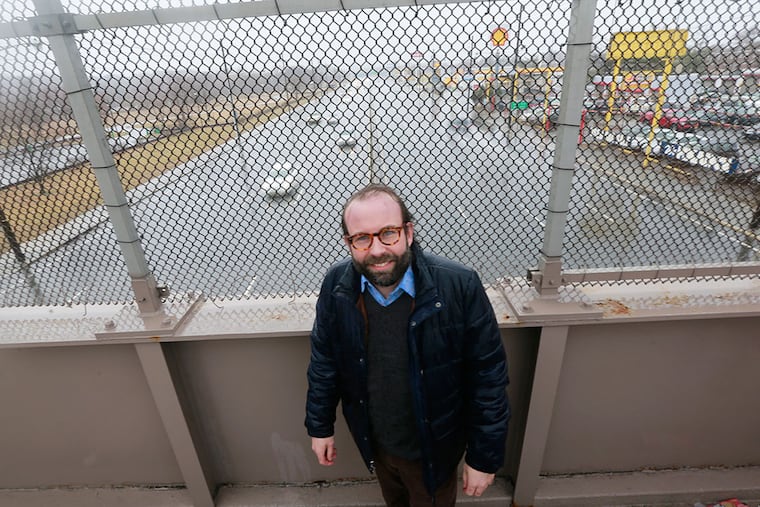Camden's boulevard of unfulfilled dreams
Eight flood-prone lanes of traffic and two miles of dreams that have been stalling, falling short, or failing for nearly 100 years.

Eight flood-prone lanes of traffic and two miles of dreams that have been stalling, falling short, or failing for nearly 100 years.
That's how I see the Admiral Wilson Boulevard, which recently became the first South Jersey highway included in the online Encyclopedia of Greater Philadelphia (philadelphiaencyclopedia.org).
But the erudite author of the encyclopedia entry takes a longer, broader, bigger-picture view of what is arguably one of the region's least loved, yet most lore-laden, thoroughfares.
"Admiral Wilson Boulevard is one of the most important roadways of the early 20th century," Rutgers-Camden reference librarian Bart Everts says during our conversation on campus this week. The encyclopedia is a project of the Mid-Atlantic Regional Center for the Humanities at Rutgers-Camden.
"The boulevard was the first 'auto strip' in the United States," Everts says. "It was designed around the car, and it predicted transportation policies and development" patterns.
"It became a model that would be replicated all over the country."
Everts, 41, grew up in Collingswood and remembers the go-go Boulevard of the 1980s and early '90s, when "exotic" dancing, quickie motels, a gigantic porn mart ("Nude Girl Sex Show!") and 60-mile-an-hour prostitution made it infamous.
(In 1990, one enterprising sex worker attracted attention with a boom box blasting the hit tune "Let's Talk About Sex." Ah, the good old days).
"I was always curious why this particular road was where those types of businesses were operating," Everts says. "It was as if Camden became a dumping ground for what other places didn't want."
Matters were far different in the early 1920s, he writes, when the boulevard was envisioned as a landscaped parkway along the Cooper River.
The Camden stretch of Route 30 was to be lined with sidewalks and trees. It would carry motorists into and out of the city, as well as to and from what is now the Benjamin Franklin Bridge.
Designs by the eminent urban planner Charles W. Leavitt Jr. called for construction of a civic center and other grand structures on or near the boulevard to help establish Camden as a metropolis in its own right.
But by 1927 - the year after the bridge opened, and the year before Leavitt was ousted from the job and then died - auto-related commerce was rapidly supplanting the grand plans.
Sears opened a monumental store with parking lot near the proposed civic center, which was never built. A few years later, the world's first drive-in movie theater debuted near the site of a drive-through "whoopee coaster."
Like the far more famous Route 66, the boulevard became a leisure-time destination.
It led to Central Airport and Crescent Boulevard (now Route 130), home to the popular Weber's Hof Brau restaurant and even a dog-racing track.
Such attractions gave way to gas stations, motels, car dealerships, and chain restaurants like White Tower and Howard Johnson's by the 1950s.
But even during this commercial zenith, "each time something changed on the boulevard, the change was met with resistance," says Everts.
He writes that when the Admiral Tavern opened in 1949, namesake Adm. Henry Braid Wilson tried to get the boulevard renamed - and vowed never to traverse it again.
And by the end of the 20th century, what cops and others called "the Stroll" had become so crime-ridden ("Boulevard of Fear," proclaimed the Camden Courier-Post) that politicos concluded salvation via destruction was the only way to go.
Anticipating that thousands of Republicans would use the road to reach the GOP's national convention in Philadelphia in 2000, then-Gov. Christie Whitman pledged, Everts writes, to "restore Admiral Wilson Boulevard to the beauty that it enjoyed long ago."
The result - a south side cleared of blight and made into a park - was initially welcomed by many, me included.
But most of the park has remained off-limits for the last 15 years.
Local residents also are still awaiting a supermarket on the boulevard's north side. The project was announced in 2013; construction has yet to begin.
"We're left with a road that has no distinct identity anymore," says Everts. "There's a place on it that looks like a park, but isn't really a park. There's supposed to be a supermarket, but it's not there yet."
Noting the Subaru corporate campus/parking lot complex now under construction on the Sears site, he adds, "What we're getting is a suburban office park."
It's enough to make a person nostalgic for the whoopee coaster.
856-779-3845 @inqkriordan